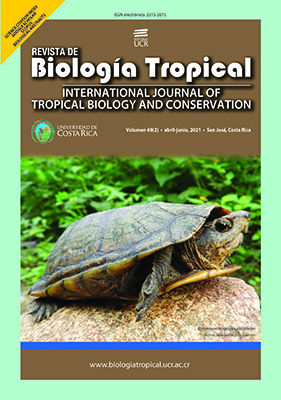Abstract
Introduction: Multiple studies have been carried out in forests affected by hurricanes, but the information obtained for Costa Rica is scarce or null, in the case of direct impacts such as Otto, so it is necessary to expand the existing knowledge about the effects of these phenomena on tropical forests and the recovery mechanisms of these biomes. Consequently, it is necessary to identify the vulnerability of ecosystems in long term and quantify the losses that are generated at different scales, as a result of the intense events of rain and strong winds. Objective: Determining behavior and recovery status in a secondary forest directly affected by Hurricane Otto in Boca Tapada, Pital, San Carlos, Costa Rica. Methods: Ten 20 x 50 m sampling units were systematically distributed within a secondary forest affected by Hurricane Otto in Boca Tapada, San Carlos. The current condition of the forest was evaluated, the species that received the most damage due to high winds were identified, as well as those that have the capacity to recover through regrowths. An overflight was carried out with an unmanned aerial vehicle and an orthomosaic was constructed, subsequently digitized, and classified according to the state of the forest cover presented in three evaluated moments, initial condition, after logging and the condition at the time of sampling. Population density, diversity, and basal area, were compared to data obtained in an adjacent primary forest also affected by the passage of Hurricane Otto. Results: It was obtained that 69.5 % of individuals with d ≥ 5 cm are in good condition, 20.3 % were broken in the tree canopy and 12.7% inclined without exposure of the roots. The family that provided the greatest species richness is Fabaceae, which is the same with the greatest abundance of damaged individuals and the one with the highest number of species with the ability to resprouting. The species that suffered the most damage was Couma macrocarpa (Euphorbiaceae). The initial area of forest cover was reduced by 7.63 % due to logging and 44.25 % due to Hurricane Otto. It was determined that there are significant differences in species diversity (P = 0.0004; α = 0.05) and in the density of individuals (P = 0.0011; α = 0.05). The secondary forest has the highest average in both cases. There are no significant differences in the values of the basal area (P = 0.6951; α = 0.05). Conclusions: 30.5 % of the forest mass was affected by the passage of Hurricane Otto and the Fabaceae family plays an important role in forest recovery. In addition, forest harvesting in a forest can increase the risk of being affected by the passage of hurricanes and the secondary forest has a greater diversity of species and a higher density of individuals than the primary forest.
##plugins.facebook.comentarios##

This work is licensed under a Creative Commons Attribution 4.0 International License.
Copyright (c) 2021 Ezequiel Fallas Montero, Braulio Vílchez Alvarado







